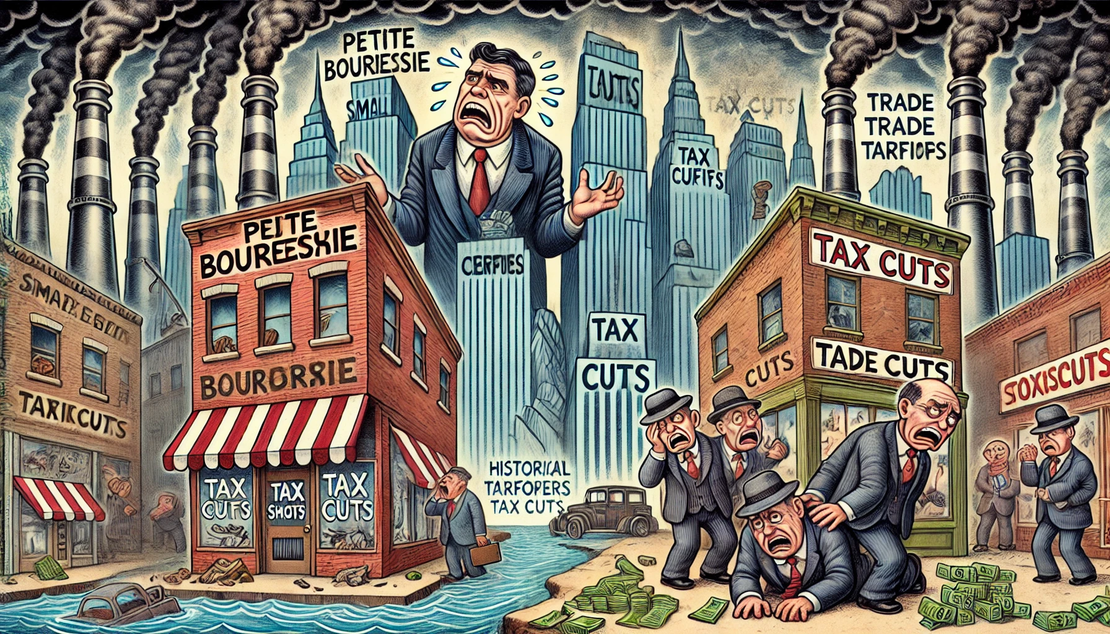Is the Petite Bourgeoisie Waking Up to Reality in the USA?
The United States enjoyed a remarkable period of economic prosperity and social stability between the post-World War II era and the early 1980s. During this time, the petite bourgeoisie — the small business owners, independent professionals, and middle-class workers — thrived as the backbone of the American Dream. However, recent decades have seen this group face mounting challenges. Now, the question arises: is the petite bourgeoisie waking up to the economic and political realities that have eroded their former stability?
The Golden Era: Post-War to 1980
After World War II, the United States emerged as an economic superpower. The combination of strong industrial output, federal investment in infrastructure, and progressive policies like the G.I. Bill created fertile ground for the middle class. The petite bourgeoisie flourished during this era:
- Economic Expansion: The U.S. economy boomed with manufacturing, retail, and local services, offering numerous opportunities for small business owners.
- Social Stability: Widespread unionization and government support for homeownership helped cement the petite bourgeoisie’s role in society.
- Cultural Optimism: The ideal of upward mobility — rooted in hard work and entrepreneurial spirit — became a cornerstone of American identity.
By the 1980s, however, cracks began to appear. Deregulation, the rise of neoliberal policies, and globalization shifted the economic landscape.
The Decline of the Petite Bourgeoisie
Economic Pressures
Starting in the 1980s, shifts in economic policy began to undermine the petite bourgeoisie’s position:
- Globalization: Manufacturing jobs were outsourced, and small businesses faced growing competition from international markets.
- Corporate Consolidation: Retail giants and conglomerates squeezed out independent businesses, making it difficult for the petite bourgeoisie to compete.
- Debt and Credit Dependence: The financialization of the economy pushed small business owners into cycles of debt as access to credit replaced long-term stability.
Social and Political Alienation
The petite bourgeoisie found themselves increasingly alienated as their interests were overshadowed by those of the corporate elite and the working class. While they were once seen as a stabilizing force in society, this group began to feel squeezed from both sides.
The Impact of Trump’s 2025 Policies on the Petite Bourgeoisie
In 2025, President Donald Trump’s administration has introduced several policies with significant implications for the petite bourgeoisie:
- Tax Policies: The extension of the 2017 tax cuts primarily benefits corporations and high-income individuals, leaving small business owners with little relief. Proposed Medicaid cuts may also affect employees and owners who rely on affordable healthcare.
- Trade and Tariff Policies: Tariffs on countries like Canada and Mexico aim to protect U.S. industries but disrupt supply chains, raising costs for small businesses.
- Regulatory Environment: Deregulation favors large corporations with resources to adapt, further pressuring smaller enterprises.
Historical Parallels
The petite bourgeoisie’s struggles under Trump’s 2025 policies echo historical challenges:
- Late 19th and Early 20th Centuries: Small businesses were squeezed between rising industrial monopolies and the working class, leading to political realignments and populist movements.
- Modern Parallels: Similar pressures today are prompting the petite bourgeoisie to reassess their strategies, with some turning to political activism, community-centered movements, and local economic initiatives.
Signs of Awakening
Recent movements suggest the petite bourgeoisie is waking up to these realities:
- Political Engagement: Advocacy for antitrust legislation and local economic protections is on the rise.
- Community-Centered Movements: Campaigns like “buy local” and cooperatives are growing in popularity.
- Cultural Shifts: Increased awareness of economic inequality and systemic challenges is reshaping the petite bourgeoisie’s narrative.
Conclusion
The golden era of the petite bourgeoisie between 1945 and 1980 was underpinned by a unique confluence of economic growth, social stability, and government support. While this group has faced significant challenges in the decades since, recent movements suggest they may be recognizing the systemic issues that threaten their position. Whether this awakening leads to lasting change remains to be seen, but the petite bourgeoisie’s response to these pressures will undoubtedly shape the future of the American economic landscape.
Further Reading
- Thomas Piketty’s “Capital in the Twenty-First Century” explores the growing wealth gap that has impacted the middle class.
- David Harvey’s “A Brief History of Neoliberalism” provides insights into the policies that reshaped the global economy after 1980.
⚠️ Please take a look at the LLM Disclaimer
